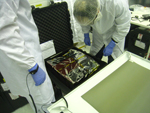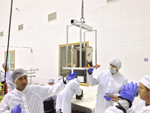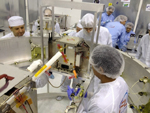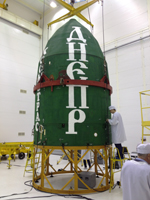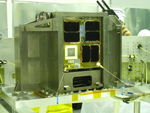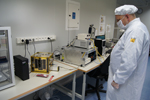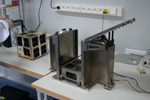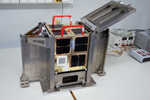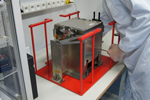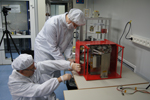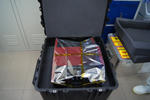
![]() More info about BRITE-PL in 2014.
More info about BRITE-PL in 2014.
![]() BRITE Constellation was included in the #7 entry in the Top Ten Science Stories of 2013, as chosen by Bob McDonald, host of the Canadian Broadcasting Corporation (CBC) radio show Quirks & Quarks, and the main science journalist for CBC radio and television.
BRITE Constellation was included in the #7 entry in the Top Ten Science Stories of 2013, as chosen by Bob McDonald, host of the Canadian Broadcasting Corporation (CBC) radio show Quirks & Quarks, and the main science journalist for CBC radio and television.
![]() In the middle of December 2013 the satellite's spatial orientation system tests have been completed. It was verified that the system is working correctly; it is able to determine the orientation of a satellite in space, the position of the orbit and it estimates the status parameters. The next step of the commissioning phase will be satellite detumbling which usually occurs immediately after separation from the ejector. Now "Lem" orbiting the Earth rotates around its own axis - it performs one turnover within 35 seconds. Such tumbling makes astronomical observations difficult or even impossible, since during photometric measurements the satellite should keep a stable orientation relative to the stars.
In the middle of December 2013 the satellite's spatial orientation system tests have been completed. It was verified that the system is working correctly; it is able to determine the orientation of a satellite in space, the position of the orbit and it estimates the status parameters. The next step of the commissioning phase will be satellite detumbling which usually occurs immediately after separation from the ejector. Now "Lem" orbiting the Earth rotates around its own axis - it performs one turnover within 35 seconds. Such tumbling makes astronomical observations difficult or even impossible, since during photometric measurements the satellite should keep a stable orientation relative to the stars. 
The image on the right shows the screen shot from ground station monitor controlling the BRITE-PL mission. On the screen one can see the track of our satellite during one orbit around the Earth and its position at a given moment.
![]() On 28 November 2013 application software was uploaded to the Attitude Determination and Control computer which controls satellite spatial orientation. Functional tests of ADCC have been completed. That concludes the first part of the commissioning phase. The correct operation of the two on-board computers (HKC and ADCC) was fully tested. Tests of other subsystems will take place in the nearest future as well as the tests of the telescope computer and calibration of the telescope.
On 28 November 2013 application software was uploaded to the Attitude Determination and Control computer which controls satellite spatial orientation. Functional tests of ADCC have been completed. That concludes the first part of the commissioning phase. The correct operation of the two on-board computers (HKC and ADCC) was fully tested. Tests of other subsystems will take place in the nearest future as well as the tests of the telescope computer and calibration of the telescope.
 During the last passes full data from previous days has been collected together with a set of housekeeping information. All technical parameters of the satellite are correct. The temperature of the satellite has increased by several degrees since the launch. The chart on the left shows how the temperature of one of "Lem" panels is changing depending on its spatial orientation and its position in orbit (the temperature increases when the satellite is lit by the Sun and it decreases when the satellite is in the shadow of the Earth).
During the last passes full data from previous days has been collected together with a set of housekeeping information. All technical parameters of the satellite are correct. The temperature of the satellite has increased by several degrees since the launch. The chart on the left shows how the temperature of one of "Lem" panels is changing depending on its spatial orientation and its position in orbit (the temperature increases when the satellite is lit by the Sun and it decreases when the satellite is in the shadow of the Earth).
![]() Regular communication with BRITE-PL "Lem" has been established and is taking place during morning and evening passes.
Regular communication with BRITE-PL "Lem" has been established and is taking place during morning and evening passes.
On Monday, Nov 25, 2013 LFFT tests (Long Form Functional Tests) of the House Keeping Computer (HKC) were completed. HKC is one of three computers installed aboard "Lem". The test completion means the end of HKC commissioning and it is the first step to reach the full functionality of the satellite. The second computer controlling the attitude control of the satellite (ADCC computer) has been turned on and is undergoing functionality tests.
| The functional tests of "Lem" has begun in orbit. The satellite operates according to the plan. |
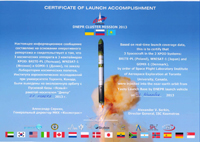
![]() After a successful launch on 21 November 2013 the first Polish scientific satellite "Lem" currently orbits the Earth. Six communication sessions with "Lem" were established till Friday midday. On Friday functional tests of satellite in the orbit started as planned.
After a successful launch on 21 November 2013 the first Polish scientific satellite "Lem" currently orbits the Earth. Six communication sessions with "Lem" were established till Friday midday. On Friday functional tests of satellite in the orbit started as planned.
![]() Four communication sessions with "Lem" were established on Thursday when significant housekeeping was received. The satellite is in good condition. The session of 9:20 am also confirmed it. Two more satellite passes over Europe and respective communication sessions are expected on Friday morning, the next are predicted for the evening.
Four communication sessions with "Lem" were established on Thursday when significant housekeeping was received. The satellite is in good condition. The session of 9:20 am also confirmed it. Two more satellite passes over Europe and respective communication sessions are expected on Friday morning, the next are predicted for the evening.
"Lem" is orbiting the Earth with an orbit cycle time of 100 minutes. The possibility of transmitting and receiving signals to/from the satellite by the ground station in Warsaw occurs when the "Lem" is in the range of our station. Due to the configuration of the orbits, the favorable conditions appear twice a day: during morning and evening passes.
![]() In the first twelve hours after inserting "Lem" in orbit communication with it was established several times. The first connection occurred on Thursday morning during the first satellite pass over Europe, the attempt to connect with the satelilte during the second pass over Warsaw failed - the most likely reason for the failure was the lack of precise coordinates of "Lem". The next communication downlink from "Lem" was achieved in the afternoon. At 5:00 pm CEST data from our satellite was received by the ground station at SFL UTIAS in Toronto, when "Lem" passed over Eastern Canada. In the subsequent pass over Canada another successful attempt took place in establishing contact with our satellite and downloading data. At 7:30 pm the ground station in Warsaw received the housekeeping data when the satellite again passed over Poland.
In the first twelve hours after inserting "Lem" in orbit communication with it was established several times. The first connection occurred on Thursday morning during the first satellite pass over Europe, the attempt to connect with the satelilte during the second pass over Warsaw failed - the most likely reason for the failure was the lack of precise coordinates of "Lem". The next communication downlink from "Lem" was achieved in the afternoon. At 5:00 pm CEST data from our satellite was received by the ground station at SFL UTIAS in Toronto, when "Lem" passed over Eastern Canada. In the subsequent pass over Canada another successful attempt took place in establishing contact with our satellite and downloading data. At 7:30 pm the ground station in Warsaw received the housekeeping data when the satellite again passed over Poland.
Currently the phase LEOP (Launch and Early Orbit Phase) is performed, the most critical period of the entire mission, in which engineers responsible for the project are monitoring and controlling the operation of the satellite transceivers after the final orbit has been achieved. The initial switch-on and functional check-out of the satellite is tested in this phase. Then commissioning test will be performed with functional end-to-end checking of subsystems, proceeding from simple to complex operations and the instrument calibration. This phase will last up to three months, and subsequently "Lem" will start its scientific activity, ie. it will perform regular observations of the brightest stars of our Galaxy.
![]() The ceremony dedicated to the launch of the First Polish Scientific Satellite to the Earth orbit took place in the Lecture Hall in Nicolaus Copernicus Astronomical Center (CAMK) at Bartycka 18 in the morning of November 21, 2013. Among guests invited to the event in CAMK there were members of the Polish Parliament, the representatives of the Polish Ministry of Science and Higher Education and the Ministry of Economy.
The ceremony dedicated to the launch of the First Polish Scientific Satellite to the Earth orbit took place in the Lecture Hall in Nicolaus Copernicus Astronomical Center (CAMK) at Bartycka 18 in the morning of November 21, 2013. Among guests invited to the event in CAMK there were members of the Polish Parliament, the representatives of the Polish Ministry of Science and Higher Education and the Ministry of Economy.
Ceremony Program:
10:45 welcome to the meeting participants by the directors of CAMK and CBK
11:00 the lecture "BRITE-PL The First Polish Scientific Satellite" of dr Piotr Orleański from CBK
11:20 bezpośrednia transmisja ze stacji kontroli lotów z CAMK i próba nawiązania kontaktu z satelitą oraz odbiór danych z orbity
11:40 the lecture "Taking the pulse of the brightest star" of prof. Gerard Handler from CAMK
11:55 the lecture "RS-20 Rocket Dniepr" of prof. Paweł Moskalik from CAMK
12:10 presentation "BRITE Ground Station"
12:15 refreshments and briefing for the media
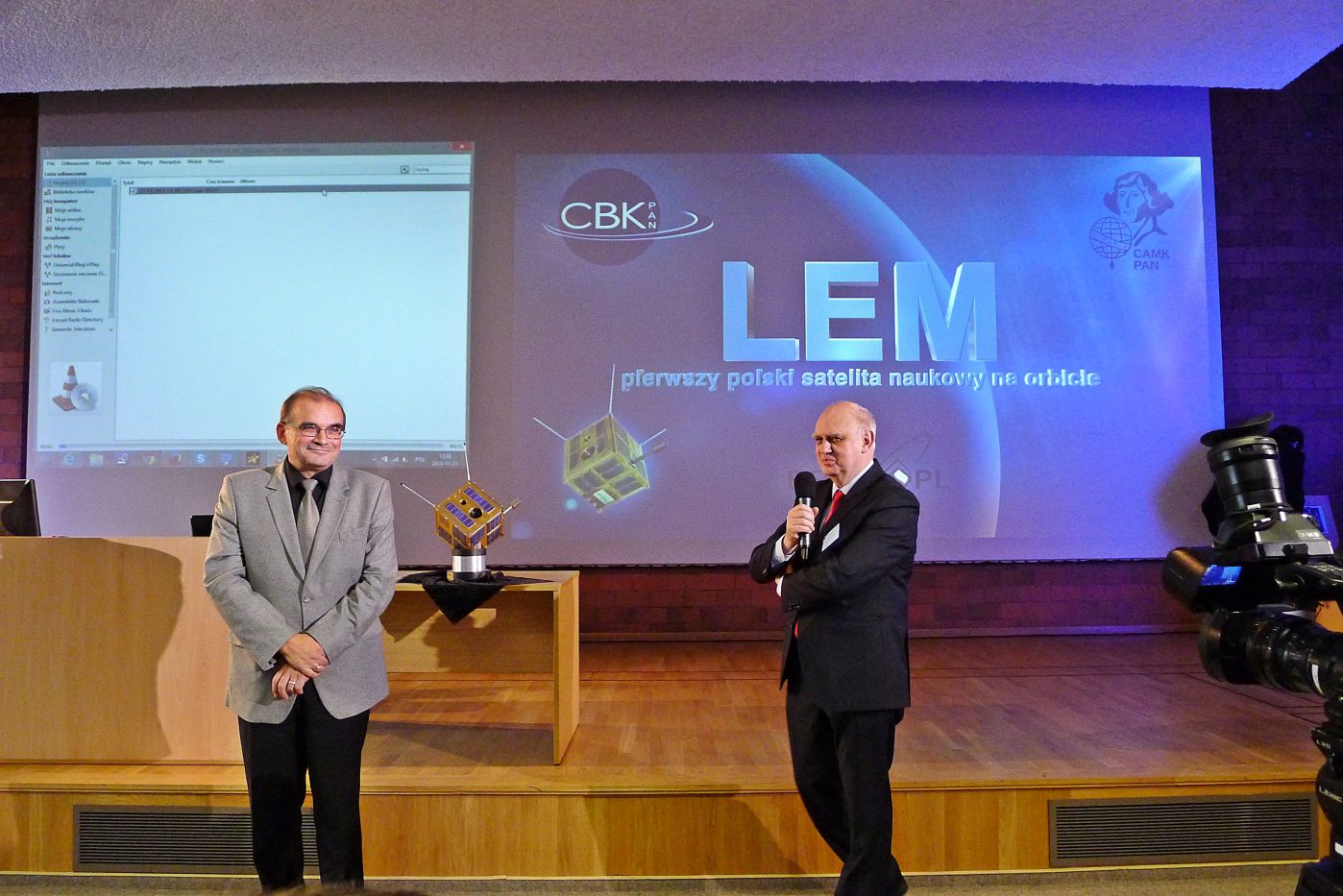 The Directors of CAMK and CBK |
 the lecture of dr inż. Piotr Orleański |
 Ground station in CAMK PAN |
 The BRITE-PL Project Manager |
![]() One hour and 38 minutes after the launch of the Dnepr rocket, during the first pass of the satellite over Europe, the connection to "Lem" was established. This was the first technical connection to the satellite, achieved in spite of the limited communication conditions, mainly because of the bad flight parameters (the low elevation). Within the period of 12 minutes the initiating command was sent to the satellite to switch-on the onboard computer, the first packet of telemetry (housekeeping) was received to get info about the health of satellite and its subsystems. Application software was loaded to HKC computer as well.
One hour and 38 minutes after the launch of the Dnepr rocket, during the first pass of the satellite over Europe, the connection to "Lem" was established. This was the first technical connection to the satellite, achieved in spite of the limited communication conditions, mainly because of the bad flight parameters (the low elevation). Within the period of 12 minutes the initiating command was sent to the satellite to switch-on the onboard computer, the first packet of telemetry (housekeeping) was received to get info about the health of satellite and its subsystems. Application software was loaded to HKC computer as well.
![]() The seperation of the satellite BRITE-PL "Lem" from the top level of the Dniepr carrier rocket occurred after 15 minutes and 50 seconds after launch at the altitude of 650 km above the Indian Ocean and in this way the Polish satellite was placed in orbit.
The seperation of the satellite BRITE-PL "Lem" from the top level of the Dniepr carrier rocket occurred after 15 minutes and 50 seconds after launch at the altitude of 650 km above the Indian Ocean and in this way the Polish satellite was placed in orbit.
![]() Video movie of the launch Dnepr rockets RS-20 with Polish satellite is available on the Kosmotras webpage.
Video movie of the launch Dnepr rockets RS-20 with Polish satellite is available on the Kosmotras webpage.
| The launch of the Polish satellite BRITE-PL "Lem" was successfully performed by RS-20 rocket Dnepr! |
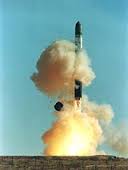
![]() On 21 November 2013 at 7:10:11 UTC time (8:10:11 CEST -Central European time CET) Russian Dnepr rocket RS-20 reached low Earth orbit with the First Polish Scientific Satellite BRITE-PL "Lem".
On 21 November 2013 at 7:10:11 UTC time (8:10:11 CEST -Central European time CET) Russian Dnepr rocket RS-20 reached low Earth orbit with the First Polish Scientific Satellite BRITE-PL "Lem".
Dnepr rocket was launched from an underground silo in Yasny military base in the Southern Urals. The Ministry of Defense of Russia is responsible for rocket launching.
Polish satellite BRITE-PL "Lem" was launched according to a contract signed by the Polish consortium of the BRITE project and Space Flight Laboratory (designer of the BRITE satellites) who hired the Ukrainian-Russian-Kazach company Kosmotras. The Polish part of the BRITE project Consortium consists of: Centrum Astronomiczne PAN im. Mikołaja Kopernika and Centrum Badań Kosmicznych PAN.
![]() In October/November 2013 BRITE-PL "Lem" satellite was being prepared for installation on the Dnepr rocket and it passed final tests. Engineers from the CBK and SFL worked on readying "Lem for launch". Because of the previous experience of SFL team, their support at this stage of the testing was to ensure maximum safety of our satellite. Polish experts took an active part in all stages of preparing LEM for take-off. Assembly took place at a launch base located 22 kilometers from the launch pad. On November 8, the assembly of the satellite with its separation device, XPOD has begun on the Dniepr rocket. About a week before launch, the military took over the entire head with all mounted satellites and relocated it to the launch pad. Below there are a few pictures from the tests in Yasny launch base.
In October/November 2013 BRITE-PL "Lem" satellite was being prepared for installation on the Dnepr rocket and it passed final tests. Engineers from the CBK and SFL worked on readying "Lem for launch". Because of the previous experience of SFL team, their support at this stage of the testing was to ensure maximum safety of our satellite. Polish experts took an active part in all stages of preparing LEM for take-off. Assembly took place at a launch base located 22 kilometers from the launch pad. On November 8, the assembly of the satellite with its separation device, XPOD has begun on the Dniepr rocket. About a week before launch, the military took over the entire head with all mounted satellites and relocated it to the launch pad. Below there are a few pictures from the tests in Yasny launch base.
![]() On 25th of September 2013, at the "Warsaw Autumn" International Festival of Contemporary Music, a musical composition entitled Machinae coelestis premiered. The piece composed for the symphony orchestra and choir commemorates the construction of the second polish scientific satellite - BRITE-PL Hevelius, named after the Polish astronomer.
On 25th of September 2013, at the "Warsaw Autumn" International Festival of Contemporary Music, a musical composition entitled Machinae coelestis premiered. The piece composed for the symphony orchestra and choir commemorates the construction of the second polish scientific satellite - BRITE-PL Hevelius, named after the Polish astronomer.
The oratio was composed by Stanislaw Krupowicz at the request of Space Research Centre PAS and "Warsaw Autumn" International Festival of Contemporary Music. It is worth mentioning that the oratio consist of three texts related to Johannes Hevelius scientific publications. Full title of his work is Machinae coelestis pars posterior, taken from The Book of Isaiah, motto of the work Selenographia and motto from the front page of Epistolae II - two Johannes Hevelius' letters. The great asset of this performance was the use of Polish Radio Concert Studio acoustic. Thanks to that, the "cosmic" nature of this composition was brought out.
After the concert, the Director of CBK, Prof. Marek Banaszkiewicz, presented to the composer and artists performing the oratorio the certificates to authenticate that the Hewelisz satellite carried the logo of "Warsaw Autumn" Festival, Camerata Silesia singers (the performers) and the name of Stanisław Krupowicz (the composer).
![]() The First Polish Scientific Satellite "Lem" has finished its last tests in the clean-room at the Centrum Badań Kosmicznych and it has started its journey to Yasny launch base leaving CBK on 23 September 2013. "Lem" will be launched on Dnepr rocket in November. Below there are a few pictures from the packing procedure.
The First Polish Scientific Satellite "Lem" has finished its last tests in the clean-room at the Centrum Badań Kosmicznych and it has started its journey to Yasny launch base leaving CBK on 23 September 2013. "Lem" will be launched on Dnepr rocket in November. Below there are a few pictures from the packing procedure.
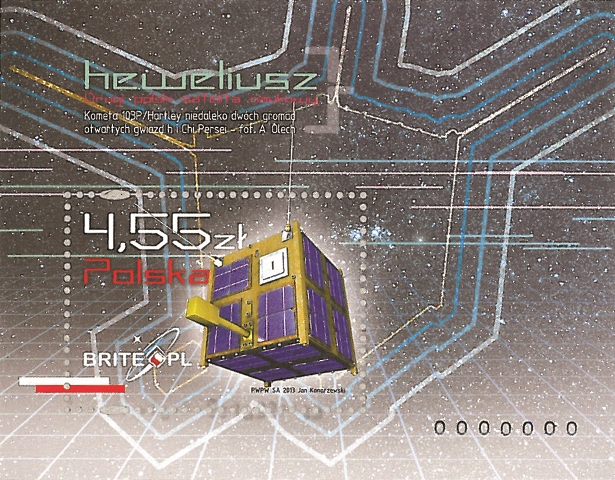
![]() On 31 July 2013 the Polish Post Office issued the stamp and the envelope FDC in commemoration of the "Heweliusz" satellite. The stamp of nominal 4,55 zł, designed by Jan Konarzewski in format of block, was issued in total printing of 300 000.
On 31 July 2013 the Polish Post Office issued the stamp and the envelope FDC in commemoration of the "Heweliusz" satellite. The stamp of nominal 4,55 zł, designed by Jan Konarzewski in format of block, was issued in total printing of 300 000.

![]() The selection of the most favorable tender in the procedure concerning launching of Polish scientific satellite BRITE-PL/Heweliusz into Earth orbit was made on 15 July 2013. The tender submitted by the company China Great Wall Industry Corporation was accepted. The launch of the rocket Long March LM-4 with "Heweliusz" satellite is planned to be at the end of 2013.
The selection of the most favorable tender in the procedure concerning launching of Polish scientific satellite BRITE-PL/Heweliusz into Earth orbit was made on 15 July 2013. The tender submitted by the company China Great Wall Industry Corporation was accepted. The launch of the rocket Long March LM-4 with "Heweliusz" satellite is planned to be at the end of 2013.
Currently the tests of Polish payload, that will be mounted on Heweliusz, have been finished and the integration of the entire satellite is continued.
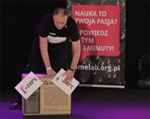
![]() The Radio Communication Manager of Polish satellites Brite-PL, Marcin Stolarski won the Polish edition of the FameLab 2013 - scientific idol contest for young scientists and engineers.
The Radio Communication Manager of Polish satellites Brite-PL, Marcin Stolarski won the Polish edition of the FameLab 2013 - scientific idol contest for young scientists and engineers.
The Final competition took place in Copernicus Science Centre in Warsaw on May 11. Ten participants competed for the top prize. Each presentation was evaluated by so called key 3C, i.e. Content, Clarity, Charisma. "The most important is the content of the presentation, clarity of expression, charisma and the specific twinkle of the person who presents the selected scientific issue" - Karolina Wojnicka, Famelab coordinator, explained.
This year the winner is Marcin Stolarski, who also represented Poland in FameLab International 2013 in Cheltenham in UK in June 2013.
![]() Contact with both Austrian satellites was made on their first passes. The telemetry is nominal and the application software has been loaded to the onboard computers. Now the telemetery will be collected onboard as well. Whole Orbit Data will be downloaded from BRITEs and analyzed.
Contact with both Austrian satellites was made on their first passes. The telemetry is nominal and the application software has been loaded to the onboard computers. Now the telemetery will be collected onboard as well. Whole Orbit Data will be downloaded from BRITEs and analyzed.


![]() Two Austrian satellites: TUGSAT-1 and UniBRITE were launched on 25 February 2013 on the rocket PSLV from Shriharikota in India. They are the first satellites of BRITE constellation. Both Austrian satellites will be operated from IKS of TUG in Graz, where a ground station and the operations centre are supported by an additional ground station build at the ITC of the Technical University Vienna.
Two Austrian satellites: TUGSAT-1 and UniBRITE were launched on 25 February 2013 on the rocket PSLV from Shriharikota in India. They are the first satellites of BRITE constellation. Both Austrian satellites will be operated from IKS of TUG in Graz, where a ground station and the operations centre are supported by an additional ground station build at the ITC of the Technical University Vienna.
![]() Interview with Professor Slavek Rucinski of the University of Toronto.
Interview with Professor Slavek Rucinski of the University of Toronto.
![]() The Cooperative Fajna Sztuka ceremonially gave a special memory card to the Director of Centrum Badań Kosmicznych PAN - Prof. Marek Banaszkiewicz. This memory card contains the photographs and the movies collected in the framework of the action "Send your photo into space". The card was then installed on the electronic board in "Heweliusz" satellite.
The Cooperative Fajna Sztuka ceremonially gave a special memory card to the Director of Centrum Badań Kosmicznych PAN - Prof. Marek Banaszkiewicz. This memory card contains the photographs and the movies collected in the framework of the action "Send your photo into space". The card was then installed on the electronic board in "Heweliusz" satellite.
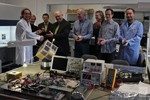 |
 |
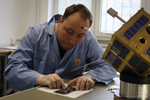 |

![]() The final announcement for the Heweliusz contest addressed to the students from the primary and secondary schools!
The final announcement for the Heweliusz contest addressed to the students from the primary and secondary schools!
The winner in the category of artwork is Bartosz Karbownik from Publiczne Gimnazjum nr 3 im.Czesława Niemena in Świebodzinie, the winner in the category slogan related to Heweliusz satellite, is: "Rewolucja umysłu. Polska 2013" proposed by students from I Liceum Ogółnokształcącego im.Kazimierza Jagiellończyka w Sieradzu: Marta Makros, Joanna Holica and Sylwia Piekarczyk.
Congratulations to the winners! Their names will be engraved on the satellite panels.
![]() The First Polish Scietific Satellite Lem is planned to be launched in third quarter of 2013 from Russian cosmodrome Yasny.
The First Polish Scietific Satellite Lem is planned to be launched in third quarter of 2013 from Russian cosmodrome Yasny.
![]() The first stage of Jan Heweliusz contest has been finished. The artworks are displayed in the contest's gallery. You are invited to vote for the artwork displayed online and for the slogan promoting Heweliusz satellite mission and the scientific project BRITE-PL.
The first stage of Jan Heweliusz contest has been finished. The artworks are displayed in the contest's gallery. You are invited to vote for the artwork displayed online and for the slogan promoting Heweliusz satellite mission and the scientific project BRITE-PL.

![]() University of Toronto offers PhD studies in BRITE Constellation data analysis. More info can be obtained from Profesor Sławomir Ruciński from University of Toronto.
University of Toronto offers PhD studies in BRITE Constellation data analysis. More info can be obtained from Profesor Sławomir Ruciński from University of Toronto.
![]() The more information about BRITE-PL.
The more information about BRITE-PL.
